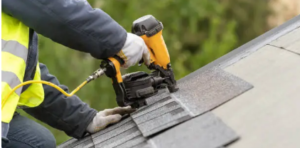Whether it be water spots on the ceiling, wet insulation, or a musty smell, leakage must be identified and fixed promptly. In this article, we discuss various leaking roof solutions Adelaide which may assist you with doing just that.
 Before beginning to address a leaky roof, it is wise to try and limit the damage as much as possible by covering affected areas with tarps or drop cloths – this may help save carpets and surfaces from extensive water damage.
Before beginning to address a leaky roof, it is wise to try and limit the damage as much as possible by covering affected areas with tarps or drop cloths – this may help save carpets and surfaces from extensive water damage.
- Roof Flashing
Roof flashing is a thin sheet of metal installed around penetrations on a roof, such as chimneys and vents, to prevent leakage into homes from coming in through any gaps between chimneys and flues. Roof flashing is integral to any comprehensive roofing system and must be sealed securely to function effectively.
Failing flashings are one of the primary sources of roof leakage, often signalled by water stains on ceilings or walls and musty smells from damp insulation. Other indicators may include rotting wood or dark areas on the underside of sheathing and rafters as signs of impending failure.
Once you discover a leak, its source must be located. Unfortunately, this may prove challenging because most roofs are sloped; therefore, where you see the leak on the interior may not correspond directly with where water comes in from outside. Also, keep a ladder handy and inspect flashing material closely for signs such as bulging shingles, rust spots near flashing material and gaps or holes.
- Tarp
One effective solution to roof leaks is covering the area with a tarp, especially if you can’t identify its source. Doing this will minimize damage caused by rainwater while providing temporary relief until professional services can repair the issue.
To use this technique, you will require two-by-fours and heavy plastic polyethylene sheeting that reaches from the eaves to the ridge and three to four feet extra of sheeting to prevent future leaks from developing.
Secure the tarp with plywood to prevent it from blowing away in a storm or strong winds, and avoid climbing onto your roof during rainstorms without appropriate equipment and knowledge to search for leaks. Doing this alone could prove dangerous!
- Sealing
Sealant can be one of the fastest and simplest leaking roof solutions Adelaide to roof leaks if you know where it’s originating. It is especially true if the source has already been discovered.
Caulk can help prevent leaks caused by rainwater and even ice dams; it should also help improve insulation and ventilation in your attic. When working on snowy or rainy roofs, wearing safety gear and ladders is wise.
Locate the source of leakage by exploring your attic or crawlspace with a flashlight, bucket and bucket lid. Look for water stains on joists that lead to the rafters or ceiling as a telltale sign of where the source lies. Also, place a bucket under any suspected leaks to collect any drips; place this bucket over plywood so as not to damage flooring or walls when filling up too fast; make sure that any filled bucket is emptied frequently to maintain safety standards.
- Replacement
Finding the leaking roof solutions Adelaide may require someone on the roof with a hose sprinkling water in various spots while someone inside looks for signs of water entering the home. A water test also involves placing plywood across joists in an attic or crawl space to form a barrier and placing a large bucket underneath to capture any dripping that passes through.
Leaks commonly occur around plumbing vent boots, roof vents, chimneys, dormers and other roof projections. While repairing from within can be challenging, sealing and repairing from outside can often stop leaks from occurring. In severe cases, replacing parts may be required – this should be seen as a long-term investment rather than an interim solution.
- Shingles
When shingles are missing or damaged, water can make its way through the roof into the home. If left unchecked, this can cause extensive water damage, rot and mould.
Leaks typically occur around penetrations of the roof, such as chimneys, vents and dormers. It is more common than leaks in areas of uninterrupted shingles. To track down a leak, start at the spot of black marks or water stains and look uphill to find the source of the problem.
